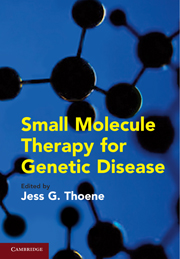Book contents
- Frontmatter
- Contents
- Contributors
- Preface
- SECTION I INFRASTRUCTURE
- SECTION II COFACTORS
- SECTION III UTILIZATION OF ALTERNATIVE PATHWAYS
- 8 Cysteamine treatment of nephropathic cystinosis
- 9 Nitisinone use in hereditary tyrosinemia and alkaptonuria
- 10 Alternative waste nitrogen disposal agents for urea cycle disorders
- 11 PDMP-based glucosylceramide synthesis inhibitors for Gaucher and Fabry diseases
- 12 Betaine treatment for the homocystinurias
- SECTION IV METAL ION THERAPY
- Index
- Plates section
- References
9 - Nitisinone use in hereditary tyrosinemia and alkaptonuria
from SECTION III - UTILIZATION OF ALTERNATIVE PATHWAYS
Published online by Cambridge University Press: 17 November 2010
- Frontmatter
- Contents
- Contributors
- Preface
- SECTION I INFRASTRUCTURE
- SECTION II COFACTORS
- SECTION III UTILIZATION OF ALTERNATIVE PATHWAYS
- 8 Cysteamine treatment of nephropathic cystinosis
- 9 Nitisinone use in hereditary tyrosinemia and alkaptonuria
- 10 Alternative waste nitrogen disposal agents for urea cycle disorders
- 11 PDMP-based glucosylceramide synthesis inhibitors for Gaucher and Fabry diseases
- 12 Betaine treatment for the homocystinurias
- SECTION IV METAL ION THERAPY
- Index
- Plates section
- References
- Type
- Chapter
- Information
- Small Molecule Therapy for Genetic Disease , pp. 114 - 134Publisher: Cambridge University PressPrint publication year: 2010
References
- 1
- Cited by

